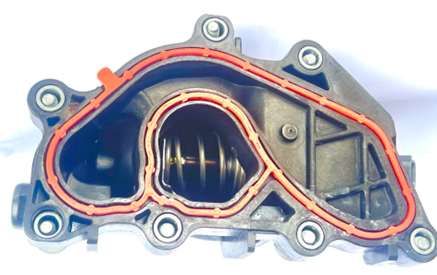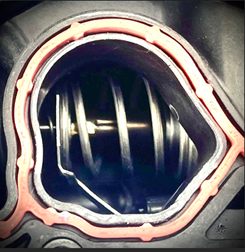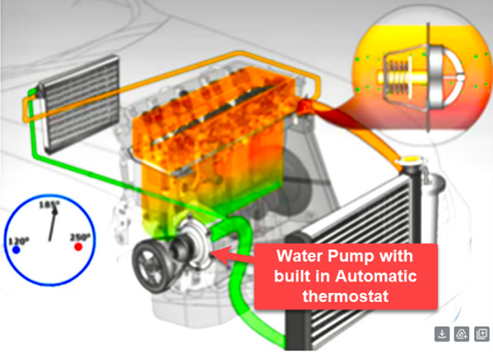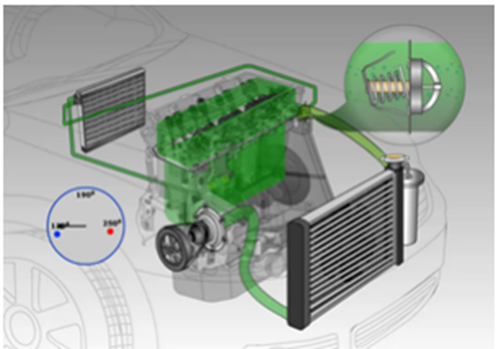Blog
Cross Section Of A Typical Water Themostat

Water enters into the right hand chamber, flows across to the right hand side and then either exits to the engine depending on whether the thermostat is either open or closed.
When the engine is cold, as in first thing in the morning, or having been parked and not driven for few hours, the thermostat will be closed. The hot water coming from the engine will returned to the engine to assist getting the engine quickly up the optimal temperature efficiency.
The sensors in the water pump to open the valve and direct the hot water to the radiator for cooling before recalculating it back to the engine. This keeps the engine at designed temperatures
Below is an image showing a close up of spring loaded mechanism which controls the flow of the water. Either directly back to the engine or to the radiator for cooling and the back to the water pump for re-circulation

Gone are the days that when indication were that the thermostat was faulty one removed it from the engine, placed it in boiling water to see it would open, then let it cool down to make sure it was cycling correctly. This was very inefficient and labour intensive. Now we attached the computer to the temperature sensor gauge when the engine is cold, run the engine for fifteen minutes, while doing other work, and then read in intemperate the graph and know for 100% sure that all the components are function or which are not.
We now use computer temperature to graph the fluctuations over time starting from a cold engine to the engine warming up until it reached optimal running temperature. We see the temperature dip as the valve opens. By following the fluctuations of the temperature gauge we can also determine when electronic
A motor car water pump is a crucial component of the engine cooling system that circulates coolant to maintain the engine’s temperature within the optimal range. Here’s a detailed explanation of how a motor car water pump works, the role of the thermostat open valve, common reasons for thermostat failure, and the consequences of a malfunctioning thermostat:
How a Motor Car Water Pump Works:
Coolant Circulation The water pump is usually belt-driven and is connected to the engine. As the engine runs, the pump impeller rotates, creating a centrifugal force that draws coolant (antifreeze, Glycol and water mixture) from the radiator. Adding glycol to a car radiator affects the boiling point and freezing point of the water in the radiator and engine. Glycol raises the boiling point and lowers the freezing point of the water mixture. The benefits of adding glycol include improved temperature regulation, protection against freezing in cold weather, and presentation of overheating in hot weather.
Pressure Increase The pump pressurizes the coolant, forcing it through the engine block and cylinder head water jackets. This helps in absorbing heat generated during combustion.
Cooling Process The heated coolant flows back to the radiator through the upper radiator hose. In the radiator, the coolant dissipates heat to the surrounding air and returns to the water pump through the lower radiator hose to continue the cycle.
Thermostat Open Valve The thermostat open valve is an essential part of the cooling system. It regulates the flow of coolant between the engine and the radiator based on the engine’s operating temperature. When the engine is cold, the thermostat remains closed to allow it to warm up quickly. Once the engine reaches the optimal operating temperature, the thermostat opens, allowing coolant to flow through the radiator for cooling.
The thermostat operates based on the engine’s temperature. It opens to allow coolant flow when the engine is hot, and closes to aid in quick warm-up during cold starts. –
Proper engine temperature regulation is crucial for engine performance, efficiency, and longevity. The thermostat ensures the engine operates at the ideal temperature range for optimal performance and emission control.
Common Reasons for Thermostat Failure
Stuck Closed Accumulated debris or corrosion can cause the thermostat to remain closed, restricting coolant flow and leading to engine overheating. –
Stuck open In this case, the thermostat fails to close, resulting in slow warm-up times, reduced fuel efficiency, and potential damage to engine components. –
Mechanical Failure: Wear and tear over time can lead to mechanical failure of the thermostat, affecting its ability to open and close properly.
Results of a Faulty Thermostat: –
If the thermostat fails to open, coolant circulation to the radiator is limited, leading to engine overheating and potential damage. –
A malfunctioning thermostat can cause inefficient engine operation, reduced fuel efficiency, and increased emissions. –
Prolonged overheating due to a faulty thermostat can result in engine damage, such as warped cylinder heads or a blown head gasket. ### Consequences of an Always Open Thermostat: –
An always open thermostat can lead to prolonged engine warm-up times, especially in colder climates, affecting heater performance and interior comfort. –
Constantly circulating coolant through the radiator can impact fuel efficiency, as the engine may run cooler than optimal, resulting in incomplete combustion. –
A thermostat stuck open can affect emission control systems, as the engine may not reach the necessary operating temperature for efficient catalytic converter operation.
The motor car water pump works in conjunction with a thermostat open valve to regulate coolant flow for engine cooling. Understanding the functions, operation, common failures, and consequences of a malfunctioning thermostat is crucial for maintaining the engine’s performance and longevity. Regular inspection and timely replacement of faulty thermostats are essential to prevent potential engine damage and ensure optimal vehicle operation.

The thermostat maintains engine temperature by flushing hot coolant and replacing it with unheated.
A stuck open thermostat allows the coolant to continuously run through and the engine to run cool. Engines operate most efficiently when they are fully warmed up. When the engine is started and the coolant is cold, the thermostat should remain closed to prevent the coolant from circulating. When the coolant is fully heated up – normally to a temperature of around 195°F / 90°C, the thermostat will open to allow the coolant to flow around the system. The thermostat helps the engine to run at the optimal temperature — not too hot, and not too cold. When a thermostat is stuck open, the engine will normally run cooler than is desired. This uses more fuel and can damage the catalytic converter. A thermostat that is stuck closed will cause the engine to overheat, potentially causing major damage.
Helpful Videos:
We have a library of interesting videos on “How cars work”
www.gilauto.com.au/how-parts-of-of-car-systems-work-intersting-educational-videos

Adding glycol to a car’s radiator increases the boiling point of the water by raising the solution’s boiling point and lowers the freezing point by reducing the solution’s freezing point. Here’s how it works:
Boiling Point Increase
- Glycol, an antifreeze compound, raises the boiling point of water by reducing the vapor pressure of the solution.
- This happens because the glycol molecules disrupt the formation of vapor molecules, requiring higher temperatures to reach the vapor pressure needed for boiling.
Freezing Point Decrease
- When glycol is added to water, it disrupts the formation of ice crystals, preventing the water from freezing at higher temperatures.
- The presence of glycol molecules interferes with the hydrogen bonding between water molecules, making it more difficult for ice crystals to form.
RECENT POSTS & TIPS
- How to Trace a Fault in an EV High Voltage Battery
- Never Lose Your Car Keys Again
- Cross Section Of A Typical Water Themostat
- Testing of EV AC Electric Motor Phase Resistance Balance Test of The Windings
- Brake Fade
- Instructions for Jump Starting a Car
- Low-Pressure Exhaust Recirculation Filter (ERF)
- Reasons for front wheel bearings to breakdown
- Brake Cylinders Failure - Detection & Consequences
- Pollen Filters
- Will a DPF regeneration cure the blocked exhaust issue?
- Why should I change the oil filter each time I change the engine oil in my car?
- What Is AdBlue ?
- Origins of Suspension Systems for Modern Vehicles
- Parasitic Battery Drain
- ELECTRIC VEHICLES – A SIMPLE EXPLANATION
- GIL’S FORESIGHT, ELECTRIC VEHICLES WERE COMING
- MECHANICS OF VARIOUS BRAKE SYSTEMS
- SCAN TOOLS DO NOT FIX CARS. HIGHLY QUALIFIED MECHANICS DO.
- TOYOTA PRIUS HYBRID BATTERY REPAIR






